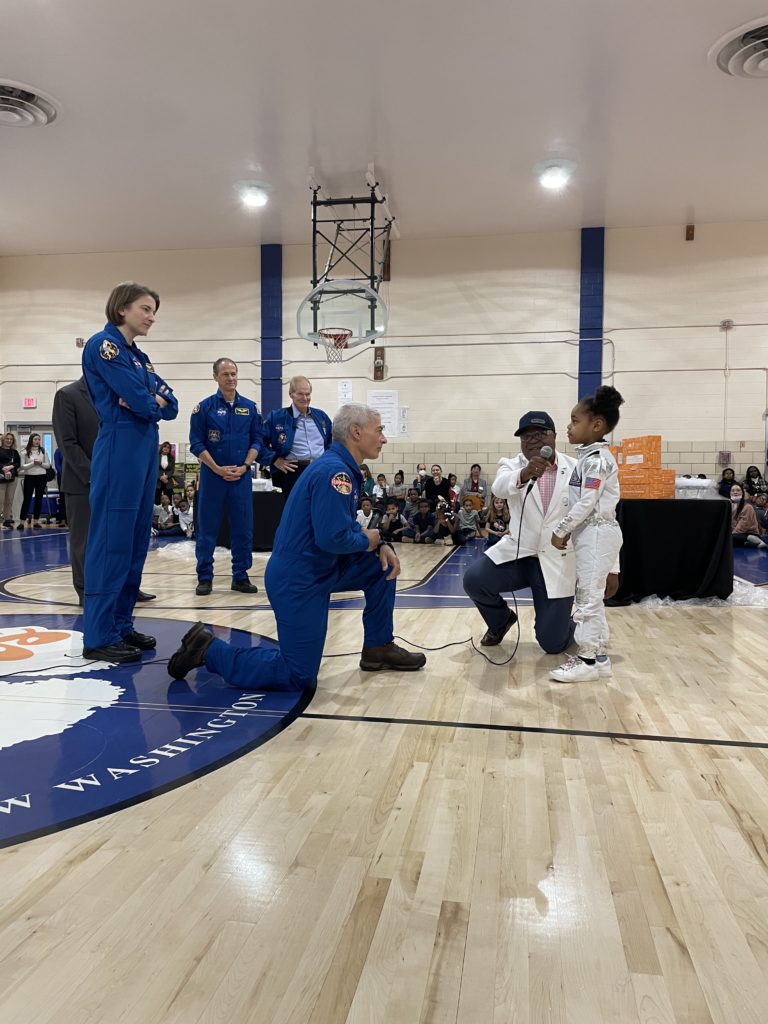
By Matthew Koehler
Christmas came a little early last month when some very special guests visited the students at Amidon-Bowen Elementary School in Southwest DC. These were no ordinary, terrestrial guests – each one of them were NASA astronauts who had spent time beyond the borders of Earth’s atmosphere. One of them, Colonel Raja Chari (U.S. Air Force ret.), had spent six months up on the International Space Station. All the visiting astronauts are part of the Artemis III crew that will once again put humanity on the surface of the moon.
“Would you like to fly in space?” NASA Administrator and former astronaut Bill Nelson asked the packed gymnasium of elementary students. The whole gymnasium obliged him with loud cheers. He followed up asking if space was “cool,” then told gathered kiddos, faculty, media, and space nerds that “space is the place.” That also garnered an enthusiastic response.
The small gymnasium was warm despite the December chill outside (the doors later had to be opened to ventilate the balmy conditions) and energized. Perhaps an apt metaphor given the morning’s guests would be that it was electrified with charged particles humming with anticipation.
“We love science, technology, and math. And these folks are going to share their time and talent with us to do some experiments,” said TaMikka Sykes, Amidon-Bowen’ principal.
In partnership with the Center of Science and Industry (COSI), NASA’s meet and greet at Amidon-Bowen was part of the Artemis Learning Lunchbox initiative. It’s a program to “help engage and inspire underserved youth around STEM, highlighting the upcoming Artemis mission which will land the first woman, and first person of color on the moon by 2025,” said Stephen White, Chief Strategy Officer, COSI. Amidon-Bowen was one of several Title I schools selected to get the boxes and meet the astronauts. “Science is everywhere, and for everyone, and we were excited to partner with NASA Administrator Bill Nelson and NASA astronauts to help inspire students,” White continued.
After some warm up speeches, the space exploring guests divided amongst several tables to conduct a few simple experiments, namely putting alka seltzer tablets in water to create mini rockets that popped off the tables (some hitting the ceiling). That and the heavy-hitter, dry ice in water – who doesn’t want to play with dry ice (disclaimer: dry ice is not a toy)?
Following the experiments, a select group of students got to ask the astronauts questions about space. The questions ranged from the size of the rockets, how to dodge asteroids or be an astronaut, and one student who deadpanned that it was “too risky” to travel in space. When asked what they thought of the event, several students gave me enthusiastic thumbs up punctuated by big smiles. Another deemed it “incredible.”
With the Artemis missions, NASA endeavors to bring a “new generation to the lunar surface to stay.” It will be the first crewed mission to the lunar surface since Apollo 17 in 1972. Artemis I, an uncrewed test flight of NASA’s new Space Launch System (SLS) and Orion spacecraft, launched in mid November of 2022 returned from its trip around the moon on December 11. Aside from returning earthlings to the moon, the Artemis missions will open the door to a new era of off-planet research, opportunity, and exploration.
“We are thrilled that NASA Administrator Nelson and the four astronauts were able to join us in bringing the Learning Lunchbox science kits to the children and families of Amidon-Bowen. The kids and teachers were very engaged,” said Andy Aichele, Senior Director of Education Engagement, COSI.
It was, indeed, a day that the students at Amidon-Bowen will long remember as they chart their own paths, both on earth or perhaps amongst the stars.

